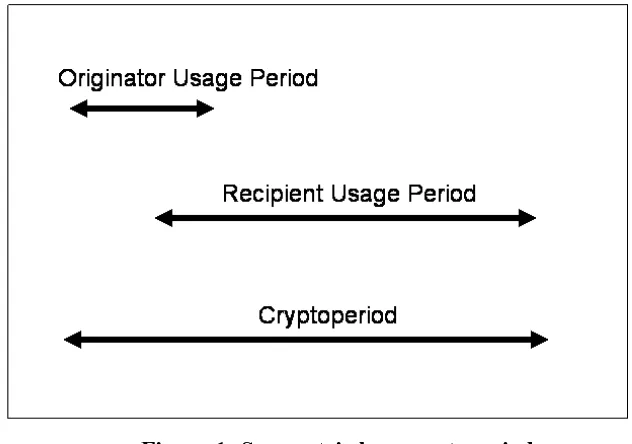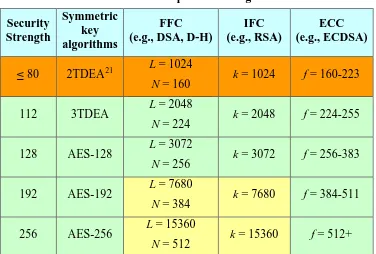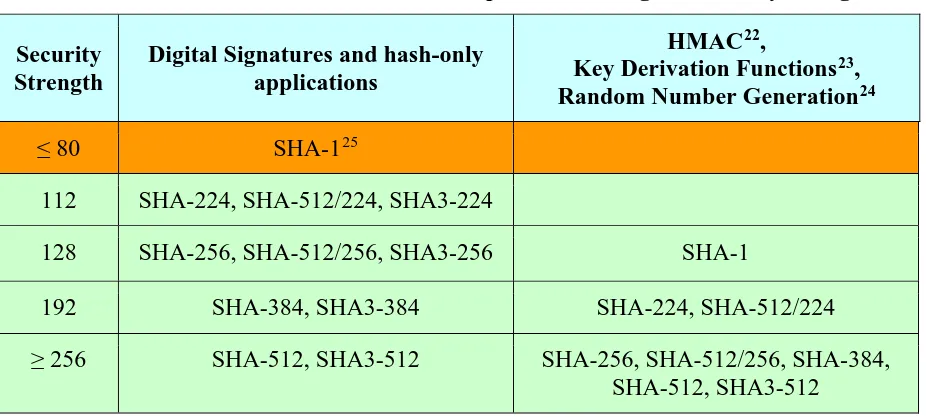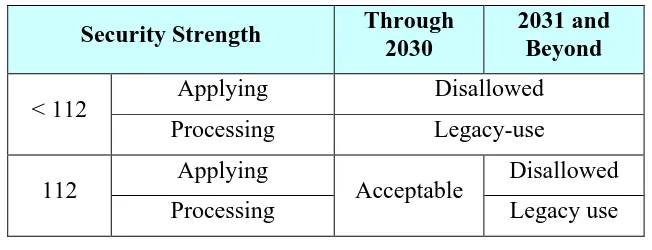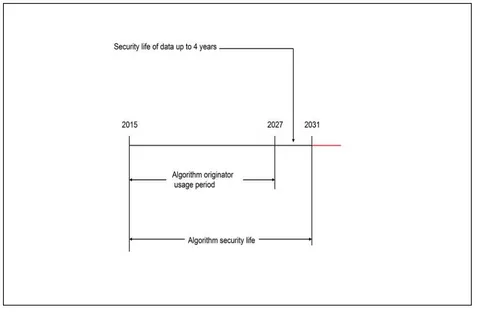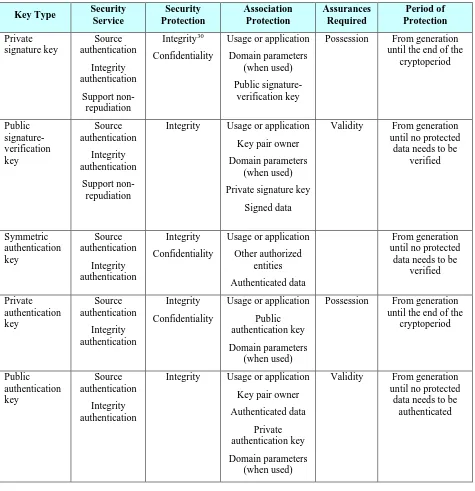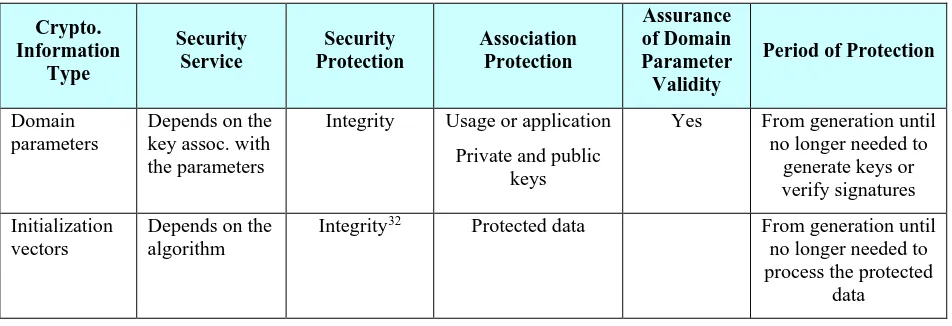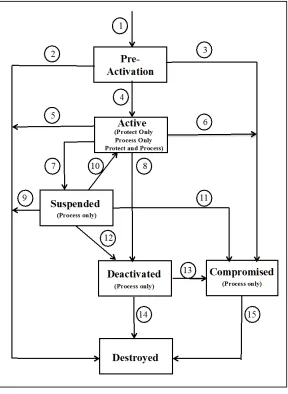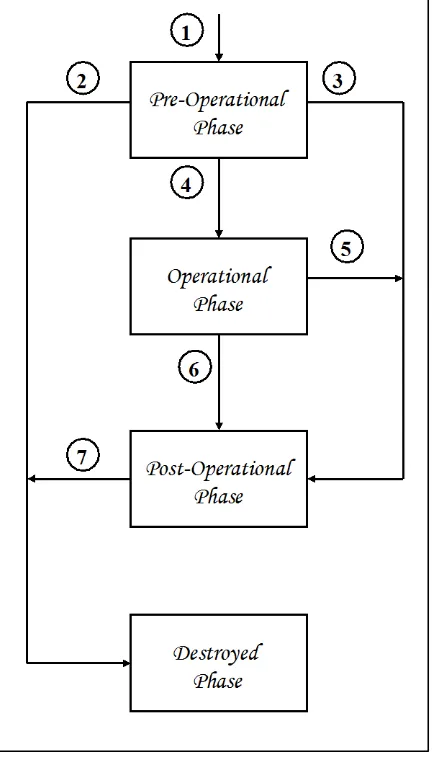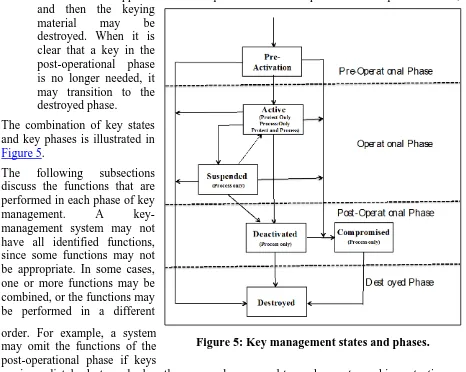NIST Special Publication 800-57 Part 1
Revision 4
Recommendation for
Key Management
Part 1: General
Elaine Barker
This publication is available free of charge from: http://dx.doi.org/10.6028/NIST.SP.800-57pt1r4
NIST Special Publication 800-57 Part 1
Revision 4
Recommendation for
Key Management
Part 1: General
Elaine Barker
Computer Security Division
Information Technology Laboratory
This publication is available free of charge from: http://dx.doi.org/10.6028/NIST.SP.800-57pt1r4
January 2016
U.S. Department of Commerce
Penny Pritzker, Secretary
National Institute of Standards and Technology
This publication has been developed by NIST in accordance with its statutory responsibilities under the Federal Information Security Modernization Act (FISMA) of 2014, 44 U.S.C. § 3541 et seq., Public Law (P.L.) 113-283. NIST is responsible for developing information security standards and guidelines, including minimum requirements for federal information systems, but such standards and guidelines shall not apply to national security systems without the express approval of appropriate federal officials exercising policy authority over such systems. This guideline is consistent with the requirements of the Office of Management and Budget (OMB) Circular A-130.
Nothing in this publication should be taken to contradict the standards and guidelines made mandatory and binding on Federal agencies by the Secretary of Commerce under statutory authority. Nor should these guidelines be interpreted as altering or superseding the existing authorities of the Secretary of Commerce, Director of the OMB, or any other Federal official. This publication may be used by nongovernmental organizations on a voluntary basis and is not subject to copyright in the United States. Attribution would, however, be appreciated by NIST.
National Institute of Standards and Technology Special Publication 800-57 Part 1, Revision 4
Natl. Inst. Stand. Technol. Spec. Publ. 800-57 Part 1, Revision 4, 160 pages (January 2016) CODEN: NSPUE2
This publication is available free of charge from: http://dx.doi.org/10.6028/NIST.SP.800-57pt1r4
Certain commercial entities, equipment, or materials may be identified in this document in order to describe an experimental procedure or concept adequately. Such identification is not intended to imply recommendation or endorsement by NIST, nor is it intended to imply that the entities, materials, or equipment are necessarily the best available for the purpose.
There may be references in this publication to other publications currently under development by NIST in accordance with its assigned statutory responsibilities. The information in this publication, including concepts and methodologies, may be used by Federal agencies even before the completion of such companion publications. Thus, until each publication is completed, current requirements, guidelines, and procedures, where they exist, remain operative. For planning and transition purposes, Federal agencies may wish to closely follow the development of these new publications by NIST.
Organizations are encouraged to review all draft publications during public comment periods and provide feedback to NIST. Many NIST cybersecurity publications, other than the ones noted above, are available at http://csrc.nist.gov/publications.
All comments are subject to release under the Freedom of Information Act (FOIA)
National Institute of Standards and Technology
Attn: Computer Security Division, Information Technology Laboratory 100 Bureau Drive (Mail Stop 8930) Gaithersburg, MD 20899-8930
Reports on Computer Systems Technology
The Information Technology Laboratory (ITL) at the National Institute of Standards and Technology (NIST) promotes the U.S. economy and public welfare by providing technical leadership for the Nation’s measurement and standards infrastructure. ITL develops tests, test methods, reference data, proof of concept implementations, and technical analyses to advance the development and productive use of information technology. ITL’s responsibilities include the development of management, administrative, technical, and physical standards and guidelines for the cost-effective security and privacy of other than national security-related information in federal information systems. The Special Publication 800-series reports on ITL’s research, guidelines, and outreach efforts in information system security, and its collaborative activities with industry, government, and academic organizations.
Abstract
This Recommendation provides cryptographic key management guidance. It consists of three parts. Part 1 provides general guidance and best practices for the management of cryptographic keying material. Part 2 provides guidance on policy and security planning requirements for U.S. government agencies. Finally, Part 3 provides guidance when using the cryptographic features of current systems.
Keywords
archive; assurances; authentication; authorization; availability; backup; compromise; confidentiality; cryptanalysis; cryptographic key; cryptographic module; digital signature; hash function; key agreement; key management; key management policy; key recovery; key transport; originator-usage period; private key; public key; recipient-usage period; secret key; split knowledge; trust anchor.
Acknowledgements
The National Institute of Standards and Technology (NIST) gratefully acknowledges and appreciates contributions by previous authors of this document on the many security issues associated with this Recommendation: William Barker, William Burr, and Timothy Polk from NIST; Miles Smid from Orion Security; and Lydia Zieglar from the National Security Agency. NIST also thanks the many contributions by the public and private sectors whose thoughtful and constructive comments improved the quality and usefulness of this
Executive Summary
The proper management of cryptographic keys is essential to the effective use of cryptography for security. Keys are analogous to the combination of a safe. If a safe combination is known to an adversary, the strongest safe provides no security against penetration. Similarly, poor key management may easily compromise strong algorithms. Ultimately, the security of information protected by cryptography directly depends on the strength of the keys, the effectiveness of mechanisms and protocols associated with the keys, and the protection afforded to the keys. All keys need to be protected against modification, and secret and private keys need to be protected against unauthorized disclosure. Key management provides the foundation for the secure generation, storage, distribution, use and destruction of keys.
Users and developers are presented with many choices in their use of cryptographic mechanisms. Inappropriate choices may result in an illusion of security, but little or no real security for the protocol or application. This Recommendation (i.e., Special Publication (SP) 800-57) provides background information and establishes frameworks to support appropriate decisions when selecting and using cryptographic mechanisms.
This Recommendation does not address the implementation details for cryptographic modules that may be used to achieve the security requirements identified. These details are addressed in Federal Information Processing Standard (FIPS) 140 [FIPS 140] and its associated implementation guidance and derived test requirements (available at
http://csrc.nist.gov/groups/STM/cmvp/).
This Recommendation is written for several different audiences and is divided into three parts:
• Part 1, General, contains basic key management guidance. It is intended to advise developers and system administrators on the "best practices" associated with key management. Cryptographic module developers may benefit from this general guidance by obtaining a greater understanding of the key management features that are required to support specific, intended ranges of applications. Protocol developers may identify key management characteristics associated with specific suites of algorithms and gain a greater understanding of the security services provided by those algorithms. System administrators may use this document to determine which configuration settings are most appropriate for their information. Part 1 of the Recommendation:
1. Defines the security services that may be provided and key types that may be employed in using cryptographic mechanisms.
2. Provides background information regarding the cryptographic algorithms that use cryptographic keying material.
4. Identifies the states in which a cryptographic key may exist during its lifetime. 5. Identifies the multitude of functions involved in key management.
6. Discusses a variety of key management issues related to the keying material. Topics discussed include key usage, cryptoperiod length, domain-parameter validation, public-key validation, accountability, audit, key management system survivability, and guidance for cryptographic algorithm and key size selection. • Part 2, General Organization and Management Requirements, is intended primarily
to address the needs of system owners and managers. It provides a framework and general guidance to support establishing cryptographic key management within an organization and a basis for satisfying the key management aspects of statutory and policy security planning requirements for Federal government organizations.
Table of Contents
Executive Summary ... iii
1 Introduction ... 1
1.1 Goal/Purpose ...1
1.2 Audience ...1
1.3 Scope ...2
1.4 Purpose of FIPS and NIST Recommendations (NIST Standards) ...3
1.5 Content and Organization ...4
2 Glossary of Terms and Acronyms ... 5
2.1 Glossary ...5
2.2 Acronyms ...16
3 Security Services ... 18
3.1 Confidentiality ...18
3.2 Data Integrity ...18
3.3 Authentication ...18
3.4 Authorization ...19
3.5 Non-repudiation ...19
3.6 Support Services ...19
3.7 Combining Services ...19
4 Cryptographic Algorithms ... 22
4.1 Classes of Cryptographic Algorithms ...22
4.2 Cryptographic Algorithm Functionality ...23
4.2.1 Hash Functions ...23
4.2.2 Symmetric-Key Algorithms used for Encryption and Decryption ...23
4.2.2.1 Advanced Encryption Standard (AES) ...23
4.2.2.2 Triple DEA (TDEA) ...24
4.2.2.3 Modes of Operation...24
4.2.3 Message Authentication Codes (MACs) ...24
4.2.3.1 MACs Using Block Cipher Algorithms ...25
4.2.3.2 MACs Using Hash Functions ...25
4.2.4 Digital Signature Algorithms ...25
4.2.5 Key Establishment Schemes ...25
4.2.5.1 Discrete-Log Key-Agreement Schemes ...26
4.2.5.2 Key Establishment Using Integer-Factorization Schemes ...26
4.2.5.3 Security Properties of the Key-Establishment Schemes ...27
4.2.5.4 Key Encryption and Key Wrapping ...27
4.2.5.5 Key Confirmation...27
4.2.6 Key Establishment Protocols ...28
5 General Key Management Guidance ... 29
5. 1 Key Types and Other Information ...29
5.1.1 Cryptographic Keys ...29
5.1.2 Other Cryptographic or Related Information ...31
5.2 Key Usage ...32
5.3 Cryptoperiods ...33
5.3.1 Risk Factors Affecting Cryptoperiods ...33
5.3.2 Consequence Factors Affecting Cryptoperiods ...34
5.3.3 Other Factors Affecting Cryptoperiods ...34
5.3.3.1 Communications versus Storage ...34
5.3.3.2 Cost of Key Revocation and Replacement ...35
5.3.4 Asymmetric Key Usage Periods and Cryptoperiods ...35
5.3.5 Symmetric Key Usage Periods and Cryptoperiods ...36
5.3.6 Cryptoperiod Recommendations for Specific Key Types ...37
5.3.7 Recommendations for Other Cryptographic or Related Information ...46
5.4 Assurances ...46
5.4.1 Assurance of Integrity (Integrity Protection) ...46
5.4.2 Assurance of Domain Parameter Validity ...46
5.4.3 Assurance of Public-Key Validity ...47
5.4.4 Assurance of Private-Key Possession ...47
5.5 Compromise of Keys and other Keying Material ...47
5.6 Guidance for Cryptographic Algorithm and Key-Size Selection ...51
5.6.1 Comparable Algorithm Strengths ...51
5.6.2 Defining Appropriate Algorithm Suites ...55
5.6.3 Using Algorithm Suites ...56
5.6.4 Transitioning to New Algorithms and Key Sizes ...57
5.6.5 Security Strength Reduction ...60
6 Protection Requirements for Cryptographic Information ... 62
6.1 Protection and Assurance Requirements ...62
6.1.1 Summary of Protection and Assurance Requirements for Cryptographic Keys 63 6.1.2 Summary of Protection Requirements for Other Cryptographic or Related Information ...67
6.2 Protection Mechanisms ...69
6.2.1 Protection Mechanisms for Cryptographic Information in Transit ...69
6.2.1.1 Availability ...69
6.2.1.2 Integrity ...69
6.2.1.3 Confidentiality ...70
6.2.1.4 Association with Usage or Application...71
6.2.1.5 Association with Other Entities ...71
6.2.2 Protection Mechanisms for Information in Storage ...71
6.2.2.1 Availability ...72
6.2.2.2 Integrity ...72
6.2.2.3 Confidentiality ...73
6.2.2.4 Association with Usage or Application...73
6.2.2.5 Association with the Other Entities...73
6.2.2.6 Association with Other Related Information ...74
6.2.3 Metadata Associated with Cryptographic Information ...74
6.2.3.1 Metadata for Keys ...74
6.2.3.2 Metadata for Related Cryptographic Information ...75
7 Key States and Transitions ... 76
7.1 Pre-activation State ...77
7.2 Active State ...78
7.3 Suspended State ...80
7.4 Deactivated State ...81
7.5 Compromised State ...82
7.6 Destroyed State ...83
8 Key-Management Phases and Functions ... 84
8.1 Pre-operational Phase ...86
8.1.1 User Registration Function ...86
8.1.2 System Initialization Function ...86
8.1.3 User Initialization Function ...86
8.1.4 Keying-Material Installation Function ...86
8.1.5 Key Establishment Function ...87
8.1.5.1 Generation and Distribution of Asymmetric Key Pairs ...87
8.1.5.1.1 Distribution of Static Public Keys ... 88
8.1.5.1.1.1 Distribution of a Trust Anchor's Public Key in a PKI ... 88
8.1.5.1.1.2 Submission to a Registration Authority or Certification Authority ... 90
8.1.5.1.1.3 General Distribution ... 92
8.1.5.1.2 Distribution of Ephemeral Public Keys ... 92
8.1.5.1.3 Distribution of Centrally Generated Key Pairs ... 92
8.1.5.2 Generation and Distribution of Symmetric Keys ...93
8.1.5.2.1 Key Generation ... 93
8.1.5.2.2 Key Distribution ... 94
8.1.5.2.2.1 Manual Key Distribution ... 94
8.1.5.2.2.2 Automated Key Distribution/Key Transport/Key Wrapping ... 94
8.1.5.2.3 Key Agreement ... 95
8.1.5.3 Generation and Distribution of Other Keying Material ...96
8.1.5.3.1 Domain Parameters ... 96
8.1.5.3.3 Shared Secrets ... 96
8.1.5.3.4 RBG Seeds ... 97
8.1.5.3.5 Other Public and Secret Information ... 97
8.1.5.3.6 Intermediate Results ... 97
8.1.5.3.7 Random Bits/Numbers ... 97
8.1.5.3.8 Passwords ... 97
8.1.6 Key Registration Function ...97
8.2 Operational Phase ...98
8.2.1 Normal Operational Storage Function ...99
8.2.1.1 Cryptographic Module Storage ...99
8.2.1.2 Immediately Accessible Storage Media ...99
8.2.2 Continuity of Operations Function ...99
8.2.2.1 Backup Storage ...99
8.2.2.2 Key Recovery Function ...101
8.2.3 Key Change Function ...102
8.2.3.1 Re-keying ...102
8.2.3.2 Key Update Function ...102
8.2.4 Key Derivation Methods ...102
8.3 Post-Operational Phase ...103
8.3.1 Archive Storage and Key Recovery Functions ...103
8.3.2 Entity De-registration Function ...107
8.3.3 Key De-registration Function ...107
8.3.4 Key Destruction Function ...108
8.3.5 Key Revocation Function ...108
8.4 Destroyed Phase ...109
9 Accountability, Audit, and Survivability ... 110
9.1 Accountability ...110
9.2 Audit ...110
9.3 Key Management System Survivability ...111
9.3.1 Backup Keys ...111
9.3.2 Key Recovery ...111
9.3.3 System Redundancy/Contingency Planning ...112
9.3.3.1 General Principles ...112
9.3.3.2 Cryptography and Key Management-specific Recovery Issues ...113
9.3.4 Compromise Recovery ...113
10 Key Management Specifications for Cryptographic Devices or Applications ... 115
10.1 Key Management Specification Description/Purpose ...115
10.2.1 Cryptographic Application ...116
10.2.2 Communications Environment ...116
10.2.3 Key Management Component Requirements ...116
10.2.4 Key Management Component Generation ...117
10.2.5 Key Management Component Distribution ...117
10.2.6 Keying Material Storage ...117
10.2.7 Access Control ...117
10.2.8 Accounting ...117
10.2.9 Compromise Management and Recovery ...118
10.2.10 Key Recovery ...118
APPENDIX A: Cryptographic and Non-cryptographic Integrity and Source Authentication Mechanisms ... 119
APPENDIX B: Key Recovery ... 122
B.1 Recovery from Stored Keying Material ...123
B.2 Recovery by Reconstruction of Keying Material ...123
B.3 Conditions Under Which Keying Material Needs to be Recoverable ...123
B.3.1 Signature Key Pairs ...123
B.3.1.1 Private Signature Keys ...124
B.3.1.2 Public Signature-verification Keys ...124
B.3.2 Symmetric Authentication Keys ...124
B.3.3 Authentication Key Pairs ...125
B.3.3.1 Public Authentication Keys ...125
B.3.3.2 Private Authentication Keys ...126
B.3.4 Symmetric Data-Encryption Keys ...126
B.3.5 Symmetric Key-Wrapping Keys ...126
B.3.6 Random Number Generation Keys ...127
B.3.7 Symmetric Master Keys ...127
B.3.8 Key-Transport Key Pairs ...127
B.3.8.1 Private Key-Transport Keys ...127
B.3.8.2 Public Key Transport Keys ...127
B.3.9 Symmetric Key Agreement Keys ...128
B.3.10 Static Key-Agreement Key Pairs ...128
B.3.10.1Private Static Key-Agreement Keys ...128
B.3.10.2Public Static Key Agreement Keys ...128
B.3.11 Ephemeral Key Pairs ...129
B.3.11.1 Private Ephemeral Keys ...129
B.3.11.2Public Ephemeral Keys ...129
B.3.12 Symmetric Authorization Keys ...129
B.3.13 Authorization Key Pairs ...129
B.3.13.2Public Authorization Keys ...130
B.3.14 Other Cryptographically Related Material ...130
B.3.14.1Domain Parameters ...130
B.3.14.2Initialization Vectors (IVs) ...130
B.3.14.3Shared Secrets ...130
B.3.14.4RBG Seeds ...130
B.3.14.5Other Public and Secret Information...131
B.3.14.6Intermediate Results ...131
B.3.14.7Key Control Information ...131
B.3.14.8Random Numbers ...131
B.3.14.9Passwords ...131
B.3.14.10 Audit Information ...131
B.4 Key Recovery Systems ...131
B.5 Key Recovery Policy ...133
APPENDIX C: References ... 135
APPENDIX D: Revisions ... 140
List of Tables Table 1: Suggested cryptoperiods for key types ...45
Table 2: Comparable strengths ...53
Table 3: Hash functions that can be used to provide the targeted security strengths ...54
Table 4: Security-strength time frames ...55
Table 5: Protection requirements for cryptographic keys ...64
Table 6: Protection requirements for other cryptographic or related material ...67
Table 7: Backup of keys ...100
Table 8: Backup of other cryptographic or related information ...101
Table 9: Archive of keys ...105
List of Figures
Figure 1: Symmetric key cryptoperiod ...37
Figure 2: Algorithm Originator-Usage Period Example ...59
Figure 3: Key state and transition example...76
Figure 4: Key management phases. ...84
1 Introduction
The use of cryptographic mechanisms is one of the strongest ways to provide security services for electronic applications and protocols and for data storage. The National Institute of Standards and Technology (NIST) publishes Federal Information Processing Standards (FIPS) and NIST Recommendations (which are published as Special Publications) that specify cryptographic techniques for protecting sensitive, unclassified information.
Since NIST published the Data Encryption Standard (DES) in 1977, the suite of approved standardized algorithms has been growing. New classes of algorithms have been added, such as secure hash functions and asymmetric key algorithms for digital signatures. The suite of algorithms now provides different levels of cryptographic strength through a variety of key sizes. The algorithms may be combined in many ways to support increasingly complex protocols and applications. This NIST Recommendation applies to U.S. government agencies using cryptography for the protection of their sensitive, unclassified information. This Recommendation may also be followed, on a voluntary basis, by other organizations that want to implement sound security principles in their computer systems.
The proper management of cryptographic keys is essential to the effective use of cryptography for security. Keys are analogous to the combination of a safe. If an adversary knows the combination, the strongest safe provides no security against penetration. Similarly, poor key management may easily compromise strong algorithms. Ultimately, the security of information protected by cryptography directly depends on the strength of the keys, the effectiveness of the mechanisms and protocols associated with the keys, and the protection afforded the keys. Cryptography can be rendered ineffective by the use of weak products, inappropriate algorithm pairing, poor physical security, and the use of weak protocols.
All keys need to be protected against unauthorized substitution and modification. Secret and private keys need to be protected against unauthorized disclosure. Key management provides the foundation for the secure generation, storage, distribution, and destruction of keys.
1.1 Goal/Purpose
Users and developers are presented with many new choices in their use of cryptographic mechanisms. Inappropriate choices may result in an illusion of security, but little or no real security for the protocol or application. This Recommendation (i.e., SP 800-57) provides background information and establishes frameworks to support appropriate decisions when selecting and using cryptographic mechanisms.
1.2 Audience
The audiences for this Recommendation for Key Management include system or application owners and managers, cryptographic module developers, protocol developers, and system administrators. The Recommendation has been provided in three parts. The different parts into which the Recommendation has been divided have been tailored to specific audiences.
Protocol developers may identify key management characteristics associated with specific suites of algorithms and gain a greater understanding of the security services provided by those algorithms. System administrators may use this Recommendation to determine which configuration settings are most appropriate for their information.
Part 2 of this Recommendation [SP800-57, Part 2] is tailored for system or application owners for use in identifying appropriate organizational key management infrastructures, establishing organizational key management policies, and specifying organizational key management practices and plans.
Part 3 of this Recommendation addresses the key management issues associated with currently available cryptographic mechanisms and is intended to provide guidance to system installers, system administrators and end users of existing key management infrastructures, protocols, and other applications, as well as the people making purchasing decisions for new systems using currently available technology.
Although some background information and rationale are provided for context and to support the recommendations, this document assumes that the reader has a basic understanding of cryptography. For background material, readers may look to a variety of NIST and commercial publications, including [SP800-32], which provides an introduction to a public-key infrastructure.
1.3 Scope
This Recommendation encompasses cryptographic algorithms, infrastructures, protocols, and applications, and the management thereof. All cryptographic algorithms currently approved by NIST for the protection of unclassified, but sensitive information are in scope.
This Recommendation focuses on issues involving the management of cryptographic keys: their generation, use, and eventual destruction. Related topics, such as algorithm selection and appropriate key size, cryptographic policy, and cryptographic module selection, are also included in this Recommendation. Some of the topics noted above are addressed in other NIST standards and guidance. This Recommendation supplements more-focused standards and guidelines.
This Recommendation does not address the implementation details for cryptographic modules that may be used to achieve the security requirements identified. These details are addressed in
[FIPS140], the FIPS 140 implementation guidance and the derived test requirements (available at http://csrc.nist.gov/ groups/STM/cmvp/standards.html).
This Recommendation also does not address the requirements or procedures for operating an archive, other than discussing the types of keying material that are appropriate to include in an archive and the protection to be provided to the archived keying material.
This Recommendation often uses “requirement” terms; these terms have the following meaning in this document:
2. should: This term is used to indicate an important recommendation. Ignoring the recommendation could result in undesirable results. Note that should may be coupled with not to become should not.
1.4 Purpose of FIPS and NIST Recommendations (NIST Standards)
Federal Information Processing Standards (FIPS) and NIST Recommendations, collectively referred to as "NIST standards," are valuable because:
1. They establish an acceptable minimal level of security for U.S. government systems. Systems that implement these NIST standards offer a consistent level of security approved for the protection of sensitive, unclassified government data.
2. They often establish some level of interoperability between different systems that implement the NIST standard. For example, two products that both implement the Advanced Encryption Standard (AES) cryptographic algorithm have the potential to interoperate, provided that the other functions of the product are compatible.
3. They often provide for scalability, because the U.S. government requires products and techniques that can be effectively applied in large numbers.
4. They are scrutinized by U.S. government experts and the public to ensure that they provide a high level of security. The NIST standards process invites broad public participation, not only through the formal NIST public review process before adoption, but also by interaction with the open cryptographic community through NIST workshops, participation in voluntary standards development organizations, participation in cryptographic research conferences and informal contacts with researchers. NIST encourages study and cryptanalysis of NIST standards, and inputs on their security are welcome at any point, from initial requirements, during development and after adoption.
5. NIST-approved cryptographic techniques are periodically re-assessed for their continued effectiveness. If any technique is found to be inadequate for the continued protection of government information, the NIST standard is revised or discontinued. 6. The algorithms specified in NIST standards (e.g., AES, TDEA, SHA-2, and DSA) and
the cryptographic modules in which they reside have required conformance tests. Accredited laboratories perform these tests on vendor implementations that claim conformance to the standards. Vendors are permitted to modify non-conforming implementations so that they meet all applicable requirements. Users of validated implementations can have a high degree of confidence that validated implementations conform to the standards.
Since 1977, NIST has developed a cryptographic “toolkit” of NIST standards1 that form a basis for the implementation of approved cryptography. This Recommendation references many of those standards, and provides guidance on how they may be properly used to protect sensitive information.
1.5 Content and Organization
Part 1, General Guidance, contains basic key management guidance. It is intended to advise developers and system administrators on the "best practices" associated with key management.
• Section 1, Introduction, establishes the purpose, scope and intended audience of the Recommendation for Key Management
• Section 2, Glossary of Terms and Acronyms, provides definitions of terms and
acronyms used in this part of the Recommendation for Key Management. The reader should be aware that the terms used in this Recommendation might be defined differently in other documents.
• Section 3, Security Services, defines the security services that may be provided using cryptographic mechanisms.
• Section 4, Cryptographic Algorithms, provides background information regarding the cryptographic algorithms that use cryptographic keying material.
• Section 5, General Key Management Guidance, classifies the different types of keys and other cryptographic information according to their uses, discusses cryptoperiods and recommends appropriate cryptoperiods for each key type, provides recommendations and requirements for other keying material, introduces assurance of domain-parameter and public-key validity, discusses the implications of the compromise of keying material, and provides guidance on cryptographic algorithm strength selection implementation and replacement.
• Section 6, Protection Requirements for Cryptographic Information, specifies the
protection that each type of information requires and identifies methods for providing this protection. These protection requirements are of particular interest to cryptographic module vendors and application implementers.
• Section 7, Key State and Transitions, identifies the states in which a cryptographic key may exist during its lifetime.
• Section 8, Key Management Phases and Functions, identifies four phases and a
multitude of functions involved in key management. This section is of particular interest to cryptographic module vendors and developers of cryptographic infrastructure services.
• Section 9, Accountability, Audit, and Survivability, discusses three control principles that are used to protect the keying material identified in Section 5.1.
• Section 10, Key Management Specifications for Cryptographic Devices or
Applications, specifies the content and requirements for key management specifications. Topics covered include the communications environment, component requirements, keying material storage, access control, accounting, and compromise recovery.
Appendices A and B are provided to supplement the main text where a topic demands a more detailed treatment. Appendix C contains a list of appropriate references, and Appendix D
2 Glossary of Terms and Acronyms
The definitions provided below are defined as used in this document. The same terms may be defined differently in other documents.
2.1 Glossary
Access control Restricts resource access to only privileged entities.
Accountability A property that ensures that the actions of an entity may be traced uniquely to that entity.
Algorithm originator-usage period
The period of time during which a specific cryptographic algorithm may be used by originators to apply protection to data (e.g., encrypt or generate a digital signature).
Algorithm security lifetime
The estimated time period during which data protected by a specific cryptographic algorithm remains secure.
Approved FIPS-approved and/or NIST-recommended. An algorithm or technique that is either 1) specified in a FIPS or NIST
Recommendation, or 2) specified elsewhere and adopted by reference in a FIPS or NIST Recommendation.
Archive 1. To place information into long-term storage. 2. A location or media used for long-term storage.
Association A relationship for a particular purpose. For example, a key is associated with the application or process for which it will be used. Assurance of (private
key) possession
Confidence that an entity possesses a private key and its associated keying material.
Assurance of validity Confidence that a public key or domain parameter is arithmetically correct.
Asymmetric key algorithm
See Public-key cryptographic algorithm.
Authentication A process that provides assurance of the source and integrity of information in communications sessions, messages, documents or stored data.
Authentication code A keyed cryptographic checksum based on an approved security function (also known as a Message Authentication Code).
Authorization Access privileges that are granted to an entity; conveying an “official” sanction to perform a security function or activity.
Backup A copy of information to facilitate recovery during the cryptoperiod of the key, if necessary.
Certificate See Public-key certificate.
Certification authority The entity in a Public Key Infrastructure (PKI) that issues certificates to certificate subjects.
Ciphertext Data in its encrypted form.
Collision Two or more distinct inputs produce the same output. Also see Hash function.
Compromise The unauthorized disclosure, modification, substitution or use of sensitive data (e.g., keying material and other security-related information).
Confidentiality The property that sensitive information is not disclosed to unauthorized entities.
Contingency plan A plan that is maintained for disaster response, backup operations, and post-disaster recovery to ensure the availability of critical resources and to facilitate the continuity of operations in an emergency situation. Contingency planning The development of a contingency plan.
Cryptanalysis 1. Operations performed to defeat cryptographic protection without an initial knowledge of the key employed in providing the protection. 2. The study of mathematical techniques for attempting to defeat
cryptographic techniques and information system security. This includes the process of looking for errors or weaknesses in the implementation of an algorithm or in the algorithm itself. Cryptographic
algorithm
A well-defined computational procedure that takes variable inputs, including a cryptographic key, and produces an output.
Cryptographic boundary
An explicitly defined continuous perimeter that establishes the physical bounds of a cryptographic module and contains all hardware, software, and/or firmware components of a cryptographic module.
Cryptographic hash function
Cryptographic key (key)
A parameter used in conjunction with a cryptographic algorithm that determines its operation in such a way that an entity with knowledge of the key can reproduce, reverse or verify the operation, while an entity without knowledge of the key cannot. Examples include:
1. The transformation of plaintext data into ciphertext data, 2. The transformation of ciphertext data into plaintext data, 3. The computation of a digital signature from data,
4. The verification of a digital signature on data,
5. The computation of an authentication code from data, 6. The verification of an authentication code from data and a
received authentication code,
7. The computation of a shared secret that is used to derive keying material.
Cryptographic key component (key component)
One of at least two parameters that have the same security properties (e.g., randomness) as a cryptographic key; parameters are combined in an approved security function to form a plaintext cryptographic key before use.
Cryptographic module The set of hardware, software, and/or firmware that implements approved security functions (including cryptographic algorithms and key generation) and is contained within a cryptographic boundary. Cryptoperiod The time span during which a specific key is authorized for use or in
which the keys for a given system or application may remain in effect. Data-encryption key A key used to encrypt and decrypt information other than keys.
Data integrity A property whereby data has not been altered in an unauthorized manner since it was created, transmitted or stored.
Decryption The process of changing ciphertext into plaintext using a cryptographic algorithm and key.
Deterministic random bit generator (DRBG)
Digital signature The result of a cryptographic transformation of data that, when properly implemented with a supporting infrastructure and policy, provides the services of:
1. Origin (i.e., source) authentication, 2. Data integrity authentication, and 3. Support for signer non-repudiation. Distribution See Key distribution.
Domain parameter A parameter used in conjunction with some public-key algorithms to generate key pairs, to create digital signatures, or to establish keying material.
Encrypted key A cryptographic key that has been encrypted using an approved security function in order to disguise the value of the underlying plaintext key.
Encryption The process of changing plaintext into ciphertext using a cryptographic algorithm and key.
Entity An individual (person), organization, device or process.
Ephemeral key A cryptographic key that is generated for each execution of a key-establishment process and that meets other requirements of the key type (e.g., unique to each message or session).
In some cases, ephemeral keys are used more than once within a single session (e.g., for broadcast applications) where the sender generates only one ephemeral key pair per message, and the private key is combined separately with each recipient’s public key.
Hash-based message authentication code (HMAC)
A message authentication code that uses an approved keyed-hash function (i.e., [FIPS 198]).
Hash function A function that maps a bit string of arbitrary (although bounded) length to a fixed-length bit string. Approved hash functions satisfy the
following properties:
1. (One-way) It is computationally infeasible to find any input that maps to any pre-specified output, and
2. (Collision resistant) It is computationally infeasible to find any two distinct inputs that map to the same output.
Identifier A bit string that is associated with a person, device or organization. It may be an identifying name, or may be something more abstract (for example, a string consisting of an IP address and timestamp),
depending on the application.
Identity The distinguishing character or personality of an entity. Initialization vector
(IV)
A vector used in defining the starting point of a cryptographic process.
Integrity (also,
Assurance of integrity)
See Data integrity.
Integrity authentication
The process of providing assurance that data has not been modified since an authentication code was created for that data.
Integrity protection See Integrity authentication.
Key See Cryptographic key.
Key agreement A key-establishment procedure where resultant keying material is a function of information contributed by two or more participants, so that no party can predetermine the value of the keying material independently of any other party’s contribution.
Key component See Cryptographic key component.
Key confirmation A procedure used to provide assurance to one party that another party actually possesses the same keying material and/or shared secret. Key de-registration A function in the lifecycle of keying material; the marking of all
keying material records and associations to indicate that the key is no longer in use.
Key derivation The process by which one or more keys are derived from either a pre-shared key or a pre-shared secret (from a key-agreement scheme), along with other information.
Key-derivation function
A function that, with the input of a cryptographic key or shared secret, and possibly other data, generates a binary string, called keying material.
Key-derivation key A key used with a key-derivation function or method to derive additional keys. Sometimes called a master key.
Key-derivation method
A key-derivation function or other approved procedure for deriving keying material.
Key distribution The transport of a key and other keying material from an entity that either owns or generates the key to another entity that is intended to use the key.
Key-encrypting key A cryptographic key that is used for the encryption or decryption of other keys to provide confidentiality protection. Also see Key-wrapping key.
Key establishment A function in the lifecycle of keying material; the process by which cryptographic keys are securely established among cryptographic modules using manual transport methods (e.g., key loaders), automated methods (e.g., key-transport and/or key-agreement protocols), or a combination of automated and manual methods.
Key length The length of a key in bits; used interchangeably with “Key size”. Key management The activities involving the handling of cryptographic keys and other
related security parameters (e.g., initialization vectors) during the entire lifecycle of the keys, including their generation, storage, establishment, entry and output, use and destruction.
Key Management Policy
A high-level statement of organizational key management policies that identifies a high-level structure, responsibilities, governing standards, organizational dependencies and other relationships, and security policies.
Key Management Practices Statement
A document or set of documents that describes, in detail, the
organizational structure, responsible roles, and organization rules for the functions identified in the Key Management Policy.
Key pair A public key and its corresponding private key; a key pair is used with a public-key algorithm.
Key recovery A function in the lifecycle of keying material; mechanisms and processes that allow authorized entities to retrieve or reconstruct keying material from key backup or archive.
Key registration A function in the lifecycle of keying material; the process of officially recording the keying material by a registration authority.
Key revocation A function in the lifecycle of keying material; a process whereby a notice is made available to affected entities that keying material should be removed from operational use prior to the end of the established cryptoperiod of that keying material.
Key transport A key-establishment procedure whereby one party (the sender) selects and encrypts (or wraps) the keying material and then distributes the material to another party (the receiver).
When used in conjunction with a public-key (asymmetric) algorithm, the keying material is encrypted using the public key of the receiver and subsequently decrypted using the private key of the receiver. When used in conjunction with a symmetric algorithm, the keying material is encrypted with a key-wrapping key shared by the two parties.
Key update A function performed on a cryptographic key in order to compute a new key that is related to the old key.
Key wrapping A method of cryptographically protecting keys using a symmetric key that provides both confidentiality and integrity protection.
Key-wrapping key A symmetric key-encrypting key that is used to provide both
confidentiality and integrity protection. Also see Key-encrypting key. Keying material The data (e.g., keys and IVs) necessary to establish and maintain
cryptographic keying relationships.
Manual key transport A non-automated means of transporting cryptographic keys by physically moving a device or document containing the key or key component.
Master key See Key-derivation key. Message
authentication code (MAC)
A cryptographic checksum on data that uses an approved security function and a symmetric key to detect both accidental and intentional modifications of data.
Metadata Information used to describe specific characteristics, constraints, acceptable uses and parameters of another data item (e.g., a cryptographic key).
NIST standards Federal Information Processing Standards (FIPS) and NIST Recommendations.
Non-repudiation A service using a digital signature that is used to support a
determination of whether a message was actually signed by a given entity.
Operational phase A phase in the lifecycle of keying material whereby keying material is used for standard cryptographic purposes.
Owner For a static key pair, the entity that is associated with the public key and authorized to use the private key. For an ephemeral key pair, the owner is the entity that generated the public/private key pair. For a symmetric key, the owner is any entity that is authorized to use the key.
Originator-usage period
The period of time in the cryptoperiod of a key during which cryptographic protection may be applied to data using that key. Password A string of characters (letters, numbers and other symbols) that are
used to authenticate an identity, to verify access authorization or to derive cryptographic keys.
Period of protection The period of time during which the integrity and/or confidentiality of a key needs to be maintained.
Plaintext Intelligible data that has meaning and can be understood without the application of decryption.
Private key A cryptographic key, used with a public-key cryptographic algorithm that is uniquely associated with an entity and is not made public. In an asymmetric (public) cryptosystem, the private key has a corresponding public key. Depending on the algorithm, the private key may be used, for example, to:
1. Compute the corresponding public key,
2. Compute a digital signature that may be verified by the corresponding public key,
3. Decrypt keys that were encrypted by the corresponding public key, or
4. Compute a shared secret during a key-agreement transaction. Proof of possession
(POP)
A verification process whereby assurance is obtained that the owner of a key pair actually has the private key associated with the public key. Pseudorandom
number generator (PRNG)
Public key A cryptographic key, used with a public-key cryptographic algorithm, that is uniquely associated with an entity and that may be made public. In an asymmetric (public) cryptosystem, the public key has a
corresponding private key. The public key may be known by anyone and, depending on the algorithm, may be used, for example, to:
1. Verify a digital signature that is signed by the corresponding private key,
2. Encrypt keys that can be decrypted using the corresponding private key, or
3. Compute a shared secret during a key-agreement transaction. Public-key certificate A set of data that uniquely identifies an entity, contains the entity's
public key and possibly other information, and is digitally signed by a trusted party, thereby binding the public key to the entity. Additional information in the certificate could specify how the key is used and its validity period.
Public-key (asymmetric) cryptographic algorithm
A cryptographic algorithm that uses two related keys: a public key and a private key. The two keys have the property that determining the private key from the public key is computationally infeasible.
Public Key
Infrastructure (PKI)
A framework that is established to issue, maintain and revoke public-key certificates.
Random bit generator (RBG)
A device or algorithm that outputs a sequence of bits that appears to be statistically independent and unbiased. Also, see Random number generator.
Random number generator (RNG)
A process used to generate an unpredictable series of numbers. Also called a Random bit generator (RBG).
Recipient-usage period
The period of time during which the protected information is processed (e.g., decrypted).
Registration authority A trusted entity that establishes and vouches for the identity of a user. Retention period The minimum amount of time that a key or other cryptographically
related information should be retained in an archive.
Secret key A cryptographic key that is used with a secret-key (symmetric) cryptographic algorithm that is uniquely associated with one or more entities and is not made public. The use of the term “secret” in this context does not imply a classification level, but rather implies the need to protect the key from disclosure.
Secure communication protocol
A communication protocol that provides the appropriate
confidentiality, source authentication, and data integrity protection. Security domain A system or subsystem that is under the authority of a single trusted
authority. Security domains may be organized (e.g., hierarchically) to form larger domains.
Security life of data The time period during which the security of the data needs to be protected (e.g., its confidentiality, integrity or availability).
Security services Mechanisms used to provide confidentiality, integrity authentication, source authentication and/or support non-repudiation of information. Security strength
(Also “bits of security”)
A number associated with the amount of work (that is, the number of operations) that is required to break a cryptographic algorithm or system. In this Recommendation, the security strength is specified in bits and is a specific value from the set {80, 112, 128, 192, 256}. Note that a security strength of 80 bits is no longer considered sufficiently secure.
Seed A secret value that is used to initialize a process (e.g., a DRBG). Also see RBG seed.
Self-signed certificate A public-key certificate whose digital signature may be verified by the public key contained within the certificate. The signature on a self-signed certificate protects the integrity of the data, but does not guarantee the authenticity of the information. The trust of self-signed certificates is based on the secure procedures used to distribute them. Shall This term is used to indicate a requirement of a Federal Information
Processing Standard (FIPS) or a requirement that must be fulfilled to claim conformance to this Recommendation. Note that shall may be coupled with not to become shall not.
Shared secret A secret value that has been computed using a key-agreement scheme and is used as input to a key-derivation function/method.
Should This term is used to indicate a very important recommendation. Ignoring the recommendation could result in undesirable results. Note that should may be coupled with not to become should not.
Signature verification The use of a digital signature algorithm and a public key to verify a digital signature on data.
Source authentication The process of providing assurance about the source of information. Sometimes called identity authentication or origin authentication. Split knowledge A process by which a cryptographic key is split into n key components,
each of which provides no knowledge of the original key. The components can be subsequently combined to recreate the original cryptographic key. If knowledge of k (where k is less than or equal to n) components is required to construct the original key, then
knowledge of any k – 1 key components provides no information about the original key other than, possibly, its length.
Note that in this Recommendation, split knowledge is not intended to cover key shares, such as those used in threshold or multi-party signatures.
Static key A key that is intended for use for a relatively long period of time and is typically intended for use in many instances of a cryptographic key-establishment scheme. Contrast with an Ephemeral key.
Symmetric key A single cryptographic key that is used with a secret (symmetric) key algorithm.
Symmetric-key algorithm
A cryptographic algorithm that uses the same secret key for an operation and its complement (e.g., encryption and decryption). System initialization A function in the lifecycle of keying material; setting up and
configuring a system for secure operation.
Trust anchor 1. An authoritative entity for which trust is assumed. In a PKI, a trust anchor is a certification authority, which is represented by a certificate that is used to verify the signature on a certificate issued by that trust-anchor. The security of the validation process depends upon the authenticity and integrity of the trust anchor's certificate. Trust anchor certificates are often distributed as self-signed certificates.
2. The self-signed public key certificate of a trusted CA. Unauthorized
disclosure
An event involving the exposure of information to entities not authorized access to the information.
User See Entity.
User registration A function in the lifecycle of keying material; a process whereby an entity becomes a member of a security domain.
X.509 certificate The X.509 public-key certificate or the X.509 attribute certificate, as defined by the ISO/ITU-T X.509 standard. Most commonly (including in this document), an X.509 certificate refers to the X.509 public-key certificate.
X.509 public-key certificate
A digital certificate containing a public key for an entity and a name for that entity, together with some other information that is rendered un-forgeable by the digital signature of the certification authority that issued the certificate, encoded in the format defined in the ISO/ITU-T X.509 standard.
2.2 Acronyms
The following abbreviations and acronyms are used in this Recommendation: 2TDEA Two-key Triple Data Encryption Algorithm specified in [SP800-67]. 3TDEA Three-key Triple Data Encryption Algorithm specified in [SP800-67]. AES Advanced Encryption Standard specified in [FIPS197].
ANS American National Standard.
ANSI American National Standards Institute. CA Certification Authority.
CRC Cyclic Redundancy Check. CRL Certificate Revocation List.
DRBG Deterministic Random Bit Generator.
DSA Digital Signature Algorithm specified in [FIPS186]. ECC Elliptic Curve Cryptography.
ECDSA Elliptic Curve Digital Signature Algorithm specified in [ANSX9.62] and approved in [FIPS186].
FFC Finite Field Cryptography.
FIPS Federal Information Processing Standard.
HMAC Keyed-Hash Message Authentication Code specified in [FIPS198]. IFC Integer Factorization Cryptography.
IV Initialization Vector.
MAC Message Authentication Code.
POP Proof of Possession. RA Registration Authority. RBG Random Bit Generator. RNG Random Number Generator.
RSA Rivest, Shamir, Adelman; an algorithm approved in [FIPS186] for digital signatures and in [SP800-56B] for key establishment.
S/MIME Secure Multipurpose Internet Mail Extensions.
3
Security Services
Cryptography may be used to perform or support several basic security services: confidentiality, integrity authentication, source authentication, authorization and non-repudiation. These services may also be required to protect cryptographic keying material. In addition, there are other cryptographic and non-cryptographic mechanisms that are used to support these security services. In general, a single cryptographic mechanism may provide more than one service (e.g., the use of digital signatures can provide integrity authentication, and source authentication), but not all services.
3.1 Confidentiality
Confidentiality is the property whereby information is not disclosed to unauthorized parties. Secrecy is a term that is often used synonymously with confidentiality. Confidentiality using cryptography is achieved using encryption to render the information unintelligible except by authorized entities. The information may become intelligible again by using decryption. In order for encryption to provide confidentiality, the cryptographic algorithm and mode of operation must be designed and implemented so that an unauthorized party cannot determine the secret or private keys associated with the encryption or be able to derive the plaintext directly without using the correct keys.
3.2 Data Integrity
Data integrity is a property whereby data has not been modified in an unauthorized manner since it was created, transmitted or stored. Modification includes the insertion, deletion and substitution of data. Cryptographic mechanisms, such as message authentication codes or digital signatures, can be used to detect (with a high probability) both accidental modifications (e.g., modifications that sometimes occur during noisy transmissions or by hardware memory failures) and deliberate modifications by an adversary. Non-cryptographic mechanisms are also often used to detect accidental modifications, but cannot be relied upon to detect deliberate modifications. A more detailed treatment of this subject is provided in Appendix A.
In this Recommendation, the statement that a cryptographic algorithm "provides data integrity" means that the algorithm is used to detect unauthorized modifications. Authenticating integrity is discussed in the next section.
3.3 Authentication
Two types of authentication services can be provided using cryptography: integrity authentication and source authentication.
• An integrity authentication service is used to verify that data has not been modified, i.e., this service provides integrity protection.
• A source authentication service is used to verify the identity of the user or system that created information (e.g., a transaction or message).
When multiple individuals are permitted to share the same source authentication information (such as a password or cryptographic key), it is sometimes called role-based authentication. See [FIPS140].
3.4 Authorization
Authorization is concerned with providing an official sanction or permission to perform a security function or activity (e.g., accessing a room). Authorization is considered as a security service that is often supported by a cryptographic service. Normally, authorization is granted only after the execution of a successful source authentication2 service. A non-cryptographic analog of the interaction between source authentication and authorization is the examination of an individual’s credentials to establish their identity (the source authentication process); after verifying the individual's identity and verifying that the individual is authorized access to some resource, such as a locked room, the individual is then provided with the key (e.g., an authorization key) or password that will allow access to that resource.
Source authentication can also be used to authorize a role (such as a system administrator or audit role), rather than to identify an individual. Once authenticated for a role, an entity is authorized for all the privileges associated with that role.
3.5 Non-repudiation
In key management, non-repudiation is a term associated with digital signature keys and digital certificates that bind the name of the certificate subject to a public key. When non-repudiation is indicated for a digital signature key, it means that the signatures created by that key support not only the usual integrity and source authentication services of digital signatures, but also may (depending upon the context of the signature) indicate commitment by the certificate subject, in the same sense that a handwritten signature on a document may indicate commitment to a contract.
A real determination of non-repudiation is a legal decision with many aspects to be considered. Cryptographic mechanisms can only be used as one element in this decision (i.e., a digital signature can only be used to support a non-repudiation decision).
3.6 Support Services
The basic cryptographic security services discussed above often require other supporting services. For example, cryptographic services often require the use of key establishment and random number generation services.
3.7 Combining Services
In many applications, a combination of security services (confidentiality, integrity authentication, source authentication, and support for non-repudiation) is desired. Designers of secure systems often begin by considering which security services are needed to protect the information contained within and processed by the system. After these services have been determined, the designer then considers what mechanisms will best provide these services. Not all mechanisms are cryptographic in nature. For example, physical security may be used to protect the confidentiality of certain types of data, and identification badges or biometric
identification devices may be used for source authentication. However, cryptographic mechanisms consisting of algorithms, keys, and other keying material often provide the most cost-effective means of protecting the security of information. This is particularly true in applications where the information would otherwise be exposed to unauthorized entities.
When properly implemented, some cryptographic algorithms provide multiple services. The following examples illustrate this case:
1. A message authentication code (Section 4.2.3) can provide source authentication, as well as integrity authentication if the symmetric keys are unique to each pair of users. 2. A digital signature algorithm (Section 4.2.4) can provide source authentication and
integrity authentication, as well as support a non-repudiation decision.
3. Certain modes of encryption can provide confidentiality, integrity authentication, and source authentication when properly implemented. These modes should be specifically designed to provide these services.
However, it is often the case that different algorithms need to be employed in order to provide all the desired services.
Examples:
Consider a system where the secure exchange of information between pairs of Internet entities is needed. Some of the exchanged information requires just integrity protection, while other information requires both integrity and confidentiality protection. It is also a requirement that each entity that participates in an information exchange knows the identity of the other entity.
The designers of this example system decide that a Public Key Infrastructure (PKI) needs to be established and that each entity wishing to communicate securely is required to physically prove his or her identity to a Registration Authority (RA). This identity-proving process requires the presentation of proper credentials, such as a driver’s license, passport or birth certificate. After establishing the correct identity, an individual then generates a public static key pair; each individual that generates a key pair is considered to be the owner of that key pair. The public key of the key pair is provided to the RA, where it is incorporated with the key-pair owner’s identifier and other information into a digitally signed message for transmission to a Certification Authority (CA). The CA then composes the key-pair owner’s public-key certificate by signing the owner's public key and the identifier, along with other information. This certificate is returned to the key-pair owner or placed in a certificate repository or both. The private key remains under the sole control of the owner.
Two types of public key certificates are commonly used: certificates used for key establishment (i.e., key agreement or key transport) and certificates used for digital signatures.
secret that is known by the two entities. The shared secret may then be used to derive one or more shared symmetric keys to be used by a symmetric algorithm to provide confidentiality and/or integrity protection for data. The receiver of the data protected by the symmetric key(s) has assurance that the data came from the other entity indicated by the public-key certificate (i.e., source authentication for the symmetric keys has been obtained).
In the case of digital signature certificates, one entity (i.e., a signatory) signs data using the private key and sends the signed data to an intended recipient. The recipient obtains the signatory’s public key certificate (e.g., from the recipient or some repository), verifies the certificate using the CA’s public key, and then uses the public key in the certificate (i.e., the public key corresponding to the private key used by the signatory) to verify the signature on the received data. By using this process, the recipient obtains assurances of both the integrity and the source of the received data.
The above examples provide basic sketches of how cryptographic algorithms may be used to support multiple security services. However, it can be easily seen that the security of such systems depend on many factors, including:
a. The strength of the entity’s credentials (e.g., driver’s license, passport or birth certificate) and the identity authentication process,
b. The strength of the cryptographic algorithms used, c. The degree of trust placed in the RA and the CA, d. The strength of the key-establishment protocols, and
e. The care taken by the users in generating their keys and protecting them from unauthorized use.
4
Cryptographic Algorithms
FIPS-approved or NIST-recommended cryptographic algorithms shall be used whenever cryptographic services are required. These approved algorithms have received an intensive security analysis prior to their approval and continue to be examined to determine that the algorithms provide adequate security. Most cryptographic algorithms require cryptographic keys or other keying material. In some cases, an algorithm may be strengthened by the use of larger keys. This Recommendation advises the users of cryptographic mechanisms on the appropriate choices of algorithms and key sizes.
This section describes the approved cryptographic algorithms that provide security services, such as confidentiality, integrity authentication, and source authentication.
4.1 Classes of Cryptographic Algorithms
There are three basic classes of approved cryptographic algorithms: hash functions, symmetric-key algorithms and asymmetric-key algorithms. The classes are defined by the number of cryptographic keys that are used in conjunction with the algorithm.
Cryptographic hash functions do not require keys for their basic operation. Hash functions generate a relatively small digest (hash value) from a (possibly) large input in a way that is fundamentally one-way (i.e., it is difficult to find an input that will produce a given output). Hash functions are used as building blocks for key management, for example,
1. To provide source and integrity authentication services (Section 4.2.3) – the hash function is used with a key to generate a message authentication code;
2. To compress messages for digital signature generation and verification (Section 4.2.4); 3. To derive keys in key-establishment algorithms (Section 4.2.5); and
4. To generate deterministic random numbers (Section 4.2.7).
Symmetric-key algorithms (sometimes known as secret-key algorithms) transform data in a way that is fundamentally difficult to undo without knowledge of a secret key. The key is “symmetric” because the same key is used for a cryptographic operation and its inverse (e.g., encryption and decryption). Symmetric keys are often known by more than one entity; however, the key shall not be disclosed to entities that are not authorized access to the data protected by that algorithm and key. Symmetric key algorithms are used, for example,
1. To provide data confidentiality (Section 4.2.2); the same key is used to encrypt and decrypt data;
2. To provide source and integrity authentication services (Section 4.2.3) in the form of Message Authentication Codes (MACs); the same key is used to generate the MAC and to validate it. MACs normally employ either a symmetric key-encryption algorithm or a cryptographic hash function as their cryptographic primitive;
3. As part of the key-establishment process (Section 4.2.5); and 4. To generate deterministic random numbers (Section 4.2.7).
